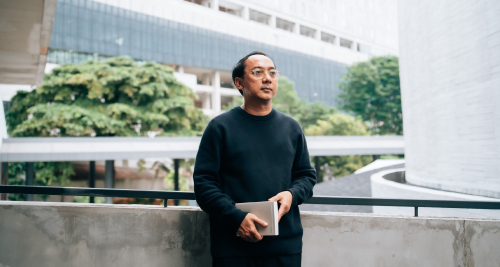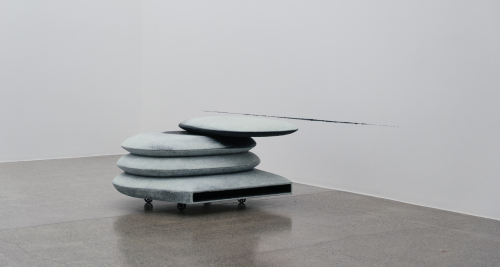Behind the Taste and Visual Identity of Lunch for My Husband
For Yori Atira, cooking is more than just a kitchen task, it is part of an urge to create something tangible and shareable. Alongside managing her fashion brand atira.works, she hones her craftsmanship in the culinary world. She calls it a passion for making. “To create a product with my hands, something tangible that can be enjoyed by myself, my family, my friends, and everyone,” she said.
This idea became the foundation for launching Lunch for My Husband in August 2020, during the COVID-19 pandemic. Before it was sold to many people, these dishes were often made by Yori at home, whether as salads, sauces, or main courses, which she would then reassemble. True to its name, Yori often prepared sandwiches for her husband to take to work. “Why sandwiches? Simply because that’s what I used to pack for my husband. Besides, I think you can taste a plate of food in a single bite of a sandwich. Savory, sweet, sour, bitter, different textures, all in harmony. Cutting it in a cross-section lets the ingredients inside present themselves and naturally create beautiful layers,” Yori said.
Yori has no formal culinary training. Her experience comes from fashion design, which she brings into the kitchen, especially when creating menus. She explains the process as designing a product, only the result is food. She works from her home kitchen, which she sees as a personal oasis away from the fast pace of a commercial kitchen. “I feel allowed to move slowly and have the chance to fully experience every spice and flavor when cooking at home,” she said. This is what led them to commit to Lunch for My Husband. “This personal sentiment will always be the driving force in running this business. Whatever the situation, we will always love what we do. Personally, I can always return to this moment in the home kitchen,” Yori explained.
The pandemic’s restrictions led Yori and her husband, Mawarid Rolansyah—known as Abang—to revive flavors from the countries they had visited. Lunch for My Husband’s menus are inspired by a variety of cuisines, many drawn from their travel memories. To this day, the menu concept and packaging remain tied to a travel theme, with each menu telling its own story. Two examples are Evard, inspired by their trip to Copenhagen, and Haruki, inspired by their travels to Japan.

Evard combines skagenröra (shrimp salad) with fresh herbal cream sauce, marinated orange, grilled zucchini, pickled red onions, fresh watercress, romaine lettuce, and toasted brioche to recall the Scandinavian dish. Haruki brings together ebi katsu with ponzu sauce, tartar sauce, wasabi, chopped pickled cucumber, takuan pickles, shredded purple cabbage, and romaine lettuce between slices of shokupan bread.
They share ingredients and preparation processes openly on their social media posts. Each menu runs for only three weeks before being replaced. Orders are taken via Instagram direct message. Sandwiches are picked up at their central kitchen in Bintaro or Ciputat, South Tangerang, or delivered on set days, usually Tuesday, Thursday, and Saturday. On delivery days, they can produce 150 to 180 sandwiches complete with sauces, pickles, and fresh salads prepared in the morning. They occasionally collaborate with small local businesses, such as bread makers or ingredient producers, for seasonal menus. Beyond production, this ensures a personal touch from start to finish. For them, transparency with customers is essential.
While Yori is fully responsible for menus and recipes, Lunch for My Husband’s visual identity is largely handled by Abang, who also works as creative director at Studio 7per8. “My role is to interpret the story, vision, and emotions Yori wants to convey in her menu through visual identity, design, and product photography, so that every element in our social media campaign ultimately builds a consistent identity for Lunch for My Husband,” he said.
In developing visual and packaging concepts, Abang and Yori draw inspiration from the visual landscapes of their travels. Their visual approach is always tied to personal stories, especially with each seasonal menu based on different personal experiences. “When LFMH first started, we drew much inspiration and reference from things that stayed in our minds and hearts while traveling. Various market visuals, from food packaging and posters to handwritten vendor signs. Our memory of colors representing cities in different countries we visited also became its own consideration. All of this we combined as the basis for choosing palette schemes, typography, layouts, and photos that could channel the memories and emotions we felt,” they explained.
Their campaigns always begin with telling the story behind the menu to be launched. The first post sets the visual tone for the entire season. That story then carries into the product launch, pre-order schedules, pop-up announcements, and other information. Each menu change is followed by a new visual exploration while maintaining the layout that has become their signature.

“Showing our product clearly, transparently, and honestly remains our top priority, including in choosing our packaging,” Abang stressed. After testing various types—from paper lunch bags to pull-out boxes and pizza boxes—they decided on a cardboard box with a transparent mica lid. While more commonly used for desserts, they adapted it for sandwiches. “We think this packaging is perfect for showing all the ingredients in the sandwich cross-section,” they said. The graphic elements on the packaging are arranged for functional efficiency. All components in the menu are listed on the label, which also acts as the seal. Everything is designed to make it clear and transparent.
“Every layer placed inside will affect our customers’ eating experience,” Abang said. “In a sandwich, there will be savory, sour, and sweet elements, as well as crunchy and soft textures. The placement of ingredients will determine which flavors start and end the first bite. The layering also affects the visual because this is the first thing customers see.”
They constantly try to work around the limits of their medium. Another challenge is how to convey emotions through a two-dimensional digital medium, which can only be experienced visually without other senses. “In product photos, for example, I always keep the composition minimal to spotlight the sandwich. I use negative space to give customers a deeper, more focused experience when viewing the images. This composition also allows me to apply graphic elements, layouts, and typography more flexibly in our social media campaigns,” Abang explained.
Their design principles give them the freedom to follow their own ideals. “Because this is our business, we have a privilege we truly value to realize our ideals,” Abang said. Designing everything himself remains a form of stress release, allowing him to explore more freely.
Since it was founded five years ago, Lunch for My Husband has produced 49 menu creations, 1,623 sandwiches, and five family members who keep their kitchen warm. For the couple, the most valuable part of their business is the connection they build. Customer experience is considered from the start of product development until the product reaches them. “We always strive to maintain a consistent emotional connection in every menu. This experience is shaped by all elements: graphic design, food, communication through DMs, storytelling in captions, music selection for social media, photos that show the background story, the tone of product photos, the taste and color of ingredients, the memories tied to that taste, the emotions of that color, and how graphics translate it,” they said. They emphasize that all components must be intertwined so that both the visuals and the food evoke the same emotion from beginning to end.
“We believe that building connections creates a special experience for every customer who orders our food,” they said. This spirit comes full circle when customers order sandwiches to be shared with loved ones across the city, just as Lunch for My Husband began.



















